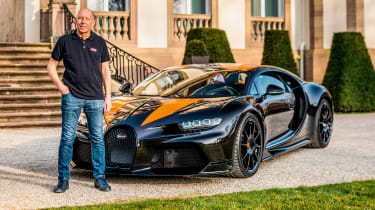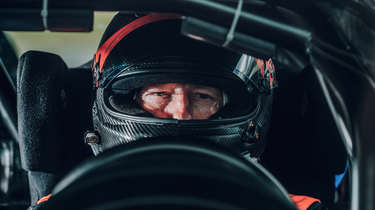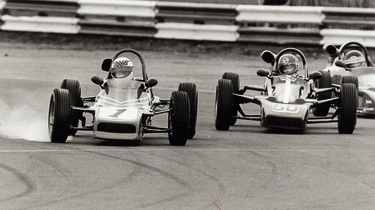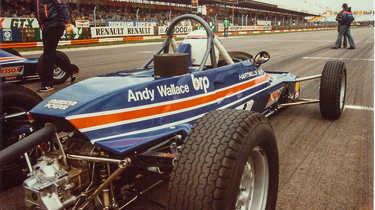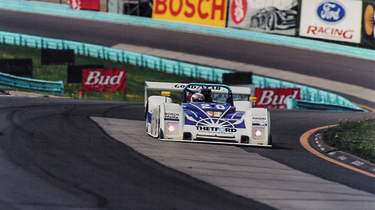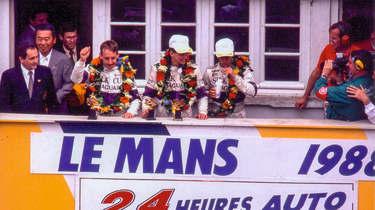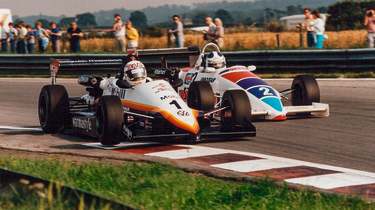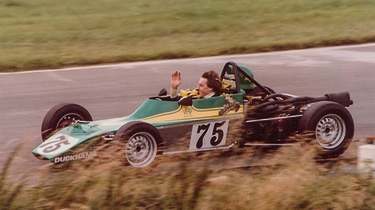My Life & Cars – Andy Wallace, racer and Bugatti test driver
From rolling his first race car to breaking the 300mph barrier with Bugatti, Andy Wallace shares his high-speed highlights
Lamborghini test driver Valentino Balboni famously owned a Fiat 500 (the ‘bambino’ version), reasoning that if you drove a Countach or Diablo for work, nothing you could afford to park on your own driveway could ever measure up. Andy Wallace is of a similar mindset. The man who has competed at the Le Mans and Daytona 24-hour races 21 times apiece, has set production-car speed records in the Jaguar XJ220 and McLaren F1, has broken the 300mph barrier in a Bugatti Chiron Super Sport and is currently Bugatti’s most illustrious test driver owns a Volkswagen ID.3. His wife drives a Golf E.
Like Balboni, Wallace’s view is that after driving race cars and hypercars for a living, no road car is going to come close to the speed or thrill. Although he does confess that a Porsche 911 GT3 is a temptation. ‘It’s one of the most track-focused supercars, and it is very, very good on the track and really good fun on the road, too. But it’s not even close to feeling like a racing car because it’s not a race car. It’s designed for a different job, at which it excels.’
> The Bugatti Chiron’s successor will feature a hybrid V16, and it sounds incredible
Wallace bought the all-electric ID.3 because of his long-term fascination with automotive technology and innovation, and was also inspired by an encounter with a Tesla Roadster back in 2009 while helping out with some evo road tests. ‘The idea was we would drag race the Tesla against a supercharged Lotus Elise. I mean, it was an electric car, how fast could it possibly be? I was driving the Lotus, but by the time I’d grabbed second gear, Roger Green in the Tesla had just disappeared. So that kind of sowed the seed in my head that electric cars could actually be something in the future.
‘It was way too early to buy electric back then, but you’ve got to start somewhere and in 2017 I bit the bullet and ordered a Golf E. I drove it everywhere. Every year we try to go skiing in Italy, 1300 kilometres each way in the middle of winter. Back then there were no charging stations to talk about anywhere, but we did it for the hell of it and because everybody said you couldn’t possibly in an electric car.
‘From then on I was hooked on electric cars. As this is evo you’re probably thinking, “This guy’s gone completely barking mad. He’s driven too fast in the past and his brain’s addled.” But I drive the ID.3 to the Bugatti factory in Molsheim on a regular basis, 840km each way. I do it with two stops of about half an hour. Piece of cake.’
Wallace says that other racing drivers also have electric cars and that travelling long distances in them demands a strategic approach that endurance racers will be familiar with. He also believes that the electric technology currently being developed by Rimac (which has a 55 per cent stake in Bugatti) is game-changing and will have a profound effect on how we view electric cars in the future.
But let’s rewind the clock, right back to Wallace’s formative years. Regular visits to the British Grand Prix, starting in the early 1970s when he was seven or eight, were the catalyst for his passion for racing. ‘My parents knew how crazy I was about racing, so for my 15th birthday they bought me a trial session at the Jim Russell race school at Silverstone. It was only up and down the straight and through some cones in a Formula Ford, but I immediately knew it was for me.
‘I told my dad that I wanted to do the full Jim Russell course, and he told me I’d have to pay for it myself. So for the next two years and two months I saved up, bought lessons when I could, and got my competition licence when I was 17 – good timing, as I couldn’t have raced before that age anyway.
‘In 1979, when I was 18, I figured out I couldn’t be a racing driver without a race car. I settled on the Formula Ford Pre-1974 series as the most affordable route into competition, then went to all the events to see which cars seemed the best, what lines people were taking through the corners, and who the good drivers were. Having worked out that I needed a Hawke DL11, I went to the bank manager to arrange a loan, telling him repayments wouldn’t be a problem as I was going to be world champion. It was a short conversation.
‘But I could get a loan for a road car, which I bought then sold the following day to finance the purchase of the Hawke from a chap in Scotland for £1250. I booked my first practice session at Silverstone, 31 August 1979, and eventually triple barrel rolled it, parking it beautifully upside down on the pole position mark on the grid. To put the damage right was just over £1000…
‘The following year, though, I did the whole championship. I won the fourth race at Cadwell Park, then a further five, and won the championship. The trouble with that, though, is that there’s no benefit to doing it again, so I had to move up the ladder, first to contemporary Formula Ford and then to Formula 3, and that brought with it a big price tag. Luckily the owner of the printing company my dad worked at was a motorsport fan, and while he couldn’t afford much in the way of sponsorship, he had lots of contacts who could also contribute little bits.’
Wallace rewarded their faith in him by winning the 1986 British Formula 3 Championship and also being named Autosport National Racing Driver of the Year. The latter achievement brought with it the chance to test the Benetton B186 Formula 1 car – ‘the turbocharged four-cylinder, one-and-a-half-litre, crazy, unbelievable engine to drive’ – but the F3 title was to have a longer lasting impact.
‘Winners of F3 championships from around the world are invited to compete in the Macau Grand Prix, a fantastic event held in November. I had actually competed there in 1985 but it didn’t go so well, but in 1986 I returned and won it. It was a really big thing. Back then F3 was a recognised stepping stone to F1, so I went and saw all the teams and said this is who I am, this is what I’ve done. They said, “Yeah, we know who you are,” and two of them offered me a drive. The stumbling block was they wanted $600,000 to put me in a car.’
Facing the irony of possessing a world-class talent but only a Third World budget, Wallace contemplated the premature demise of his racing career. But then a connection he made at the Macau Grand Prix not only remedied the immediate situation, but also laid the foundation for Wallace’s stellar career in endurance sportscar racing. In one of his two heats at Macau, Wallace tussled at very close quarters with Jan Lammers, who by that stage had swapped F1 for the World Sportscar Championship.
‘After the races Jan and I had a chat and got quite friendly. He mentioned that Jaguar was looking for one more driver for Le Mans, so he put in a good word for me. I got a call from Tom Walkinshaw [TWR ran the Silk Cut Jaguar team with its XJR-9LM racers] inviting me down to Paul Ricard for a trial. I’d never driven anything with a roof and certainly never been more than 200mph, but with Jan’s help I managed to get the drive. It saved my career.’
After warm-up races at Jerez, where his car came second, and then Road Atlanta where it was third, Wallace arrived at Le Mans in 1988, aged 27, having had no practice at the circuit – resurfacing had prevented any test days that year. Again, Lammers came to the rescue of not just Wallace, but also the third driver, Johnny Dumfries. ‘Jan taught me things I used for my entire racing career,’ reveals Wallace. ‘Having come from single-seaters where the other drivers are your enemy, it was quite odd at first being told all these things that you would normally never find out from another driver.’
The lessons of Lammers paid dividends as, despite an ailing gearbox, their Silk Cut Jaguar narrowly held off a late charge from Porsche to win the race. ‘And you know,’ chuckles Wallace, ‘winning Le Mans doesn’t do your career any harm at all. As it had been 37 years since Jaguar last won Le Mans it was a really big deal – the reception we got was amazing and we ended up meeting different members of the royal family, including the Queen.’
Although this was to be Wallace’s only outright win at Le Mans, during 21 outings there he picked up a further four class wins and drove for Toyota, McLaren, Panoz, Audi, Cadillac, Bentley, Dome, Zytek, DBA, MG-Lola and Lola. A long stint in the US, also driving in sportscar championships, saw him race in the 24 Hours of Daytona 21 times, collecting three outright victories in the process; he twice won the 12 Hours of Sebring too. During his career Wallace has been on the podium more than 70 times in top-ranking races, while his new passion for historic races means the silverware keeps coming: he won the Le Mans Classic (in Plateau Deux – Grid Two) in a Jaguar D-type in 2016 and the Daytona Classic 24 Hour in an Audi R8 LMP1 three times.
Wallace attributes his hectic race schedule for the fact he’s not owned any interesting cars. ‘At one stage I was flying back and forth across the Atlantic doing 25 to 26 races a year, plus all the testing. At its craziest I worked out that I’d sat in a race car for 121 days in one year. I didn’t have time to worry about cars of my own.’
That said, Wallace does concede that during his F3 days the fact that his race car was Volkswagen-engined entitled him to a Golf GTI Mk2 loaner – ‘It was the best thing I’d ever driven up until then.’ Similar agreements with other manufacturers that he raced for saw a couple of Jaguar XJ40s cross his driveway, a Toyota Celica that he had remapped, a selection of Audis, and when he was competing in the States, a Cadillac.
While doing pre-production testing of the Jaguar XJ220 for TWR-Jaguar in 1991, Wallace got the gig to do a top speed run with the car at Fort Stockton in Texas – the XJ220’s two-way average of 212.3mph set a new production car record. That record was broken by the McLaren F1 in 1993 (230mph) and when in 1998 it was decided that the car had more to give, it was Wallace who pushed up the maximum to 240.1mph. Since then, of course, there has been a never-ending stream of road car rocketships vying for the honour of world’s fastest. And chief protagonist in the battle for ultimate hypercar bragging rights is Wallace’s employer for the past 12 years, Bugatti.
Under attack from Hennessey, SSC and Koenigsegg, on 2 August 2019 Bugatti sent Wallace out onto the Ehra-Lessien test track in Germany in a Chiron Super Sport, where he clocked 304.773mph. It was only in one direction, so doesn’t qualify as a record, but breaking the 300mph barrier for the first time cements the names of Bugatti and Wallace in the history books.
‘It’s a massively amazing feeling when you suddenly get that number,’ enthuses Wallace. ‘You’re covering a kilometre every 7 seconds, a mile in 11 and change, and that’s on an 8.8 kilometre-long track with banked turns at either end. For somebody who has been interested in cars from a very early age, I could almost pinch myself – here I am, in the daddy of all cars, and I’m just about to exceed 300mph. Hats off to everyone involved in the project.
‘The Chiron Super Sport is an incredible car. It has 1600bhp and yet is so capable, so driveable. It’s faster and more powerful than any of my racing cars, yet is dead easy to drive. The motor industry is brilliant at making progress. I think it’s the best industry for that: it’s had to solve so many problems over the years. Now there are yet more problems, but they’ll be solved too. We don’t need to worry, I think it’s all under control.’
This story was first featured in evo issue 306.
